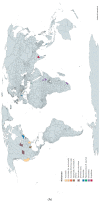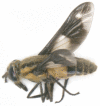Relevant Brachycera (Excluding Oestroidea) for Horses in Veterinary Medicine: A Systematic Review
- PMID: 37111454
- PMCID: PMC10142728
- DOI: 10.3390/pathogens12040568
Relevant Brachycera (Excluding Oestroidea) for Horses in Veterinary Medicine: A Systematic Review
Abstract
In equine stables and their surroundings, a large number of insects are present that can be a nuisance to their equine hosts. Previous studies about dipterans transmitting infectious agents to Equidae have largely focused on Nematocera. For the preparation of this systematic review, the existing literature (until February 2022) was systematically screened for various infectious agents transmitted to Equidae via insects of the suborder Brachycera, including Tabanidae, Muscidae, Glossinidae and Hippoboscidae, acting as pests or potential vectors. The PRISMA statement 2020 (Preferred Reporting Items for Systematic Reviews and Meta-Analyses) guidelines for systematic reviews were followed. The two concepts, Brachycera and Equidae, were combined for the search that was carried out in three languages (English, German and French) using four different search engines. In total, 38 articles investigating Brachycera as vectors for viral, bacterial and parasitic infections or as pests of equids were identified. Only 7 of the 14 investigated pathogens in the 38 reports extracted from the literature were shown to be transmitted by Brachycera. This review clearly shows that further studies are needed to investigate the role of Brachycera as vectors for pathogens relevant to equine health.
Keywords: Brachycera; Diptera; Equidae; equids; fly; transmission; vector.
Conflict of interest statement
The authors declare that Dr. Hans-Peter Fuehrer is Guest Editor for the Special Issue “Advances in Parasitic Diseases”. The authors declare no other conflict of interest, financial or otherwise.
Figures








References
-
- Hall R.D., Gerhardt R.R. 8—Flies (Diptera) In: Mullen G.R., Durden L., editors. Medical and Veterinary Entomology. Academic Press; San Diego, CA, USA: 2002. pp. 127–145.
-
- Integrated Taxonomic Information System—Report—Brachycera: Taxonomic Serial No.: 130052. [(accessed on 16 March 2023)]; Available online: https://www.itis.gov/servlet/SingleRpt/SingleRpt?search_topic=TSN&anchor....
-
- Chvala M. Fauna Europaea: Tabanidae. Fauna Europaea Version 2022.02. [(accessed on 10 August 2022)]. Available online: https://fauna-eu.org.
Publication types
LinkOut - more resources
Full Text Sources

